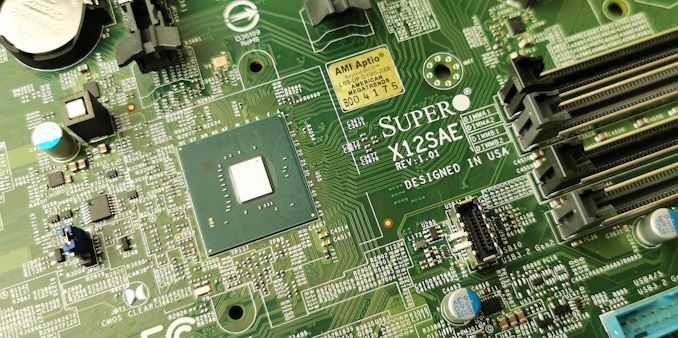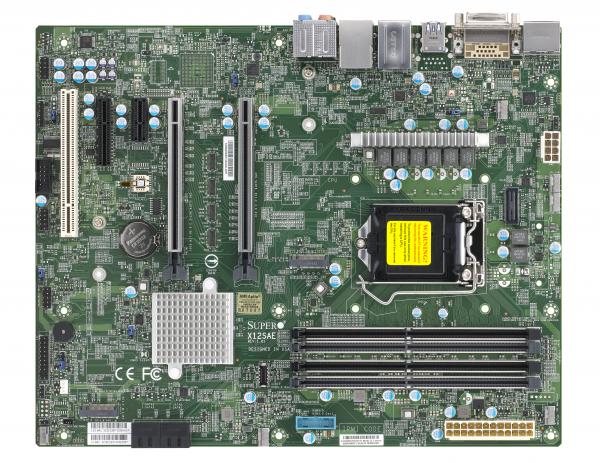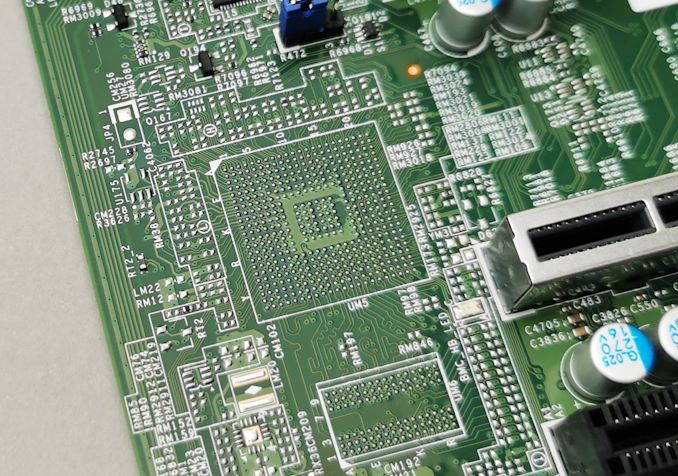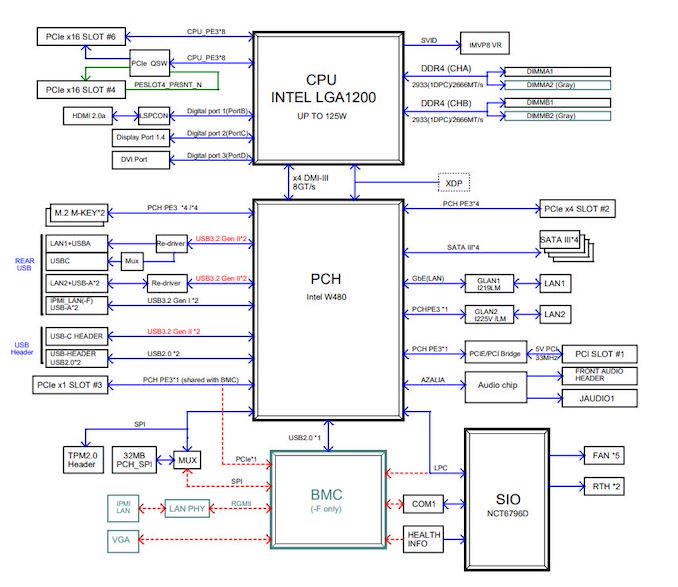Supermicro X12SAE W480 Motherboard Review: For Xeon W-1200 Workstations
by Gavin Bonshor on December 11, 2020 9:30 AM EST
We have seen numerous Intel Z490 motherboards over the months since Intel's platform for Comet Lake was announced back in April. While the Z490 is designed for regular consumers and gamers who intend to use the desktop Intel Core i5/i7/i9 processors, Intel also launched its W480 chipset slightly later which is designed for its workstation orientated Xeon W-1200 series. One such board designed specifically for the Xeon W-1200 processors is the Supermicro X12SAE with support for up to 128 GB of DDR4-2933 of ECC and non-ECC UDIMMs. Also included in the feature set are two PCIe 3.0 x4 M.2 slots, dual Ethernet including a 2.5 Gigabit controller, as well as a dedicated Intel PHY with Intel AMT and vPro support.
Supermicro X12SAE Overview
For every current W480 model on the market, there are at least 4-5 Z490 variants, which makes Intel's workstation platform slim pickings for choice. One of the reasons behind this is down to necessity, with workstations platforms opting for functionality and core feature sets over bling and fancy designs. What the Supermicro X12SAE lacks in visual appeal, it makes up for in its feature set with much of what we have come to expect from its mid-level professional models. The X12SAE is the only conventional ATX sized model from a trio we looked at when we overviewed the W480 chipset earlier on in the year, and as such, has a lot of features included on its green and basic looking PCB. This unit is designed for mass workstation deployment, rather than aesthetics.
Included in the specifications is a pair of PCIe 3.0 x4 M.2 slots, with drives in both M.2 2280/22110 form factors supported. The X12SAE has a total of four SATA ports with support for RAID 0, 1, 5, and 10 RAID arrays, with dual LAN on the rear panel, one 2.5 GbE controller, and the other via an Intel Gigabit PHY. The glaring difference between the LGA1200 Z490 and W480 chipsets supports ECC memory, albeit unbuffed, with the X12SAE allowing for up to 128 GB of DDR4-2933 across four memory slots. For expansion cards, Supermicro includes three full-length PCIe 3.0 slots operating at x16 and x8/x8/+x4, with one PCIe 3.0 x1 and a single 5 V PCI 5 V 32bit slot.
While there is space on the board for a BMC chip, as shown by the pads above, this model does not have it - users should look to the X12SCA-F for a BMC.
On-board audio is quite standard for a board of this caliber as it uses a decent yet aging HD audio codec, with other rear panel connections including a trio of video outputs consisting of an HDMI, DisplayPort, and DVD-D port. There's also USB aplenty, with support for up to five USB 3.2 G2 ports (four rear panel, one internal), with Type-A and Type-C, as well as three USB 3.2 G1, and two USB 2.0.
Supermicro X12SAE Block Diagram
Comparing the Supermicro X12SAE paired with an Intel Xeon W-2170 processor with the rest of the LGA1200 models we've tested so far, albeit, with an Intel Core i7-10700K (closely matched), we saw the expected levels of performance. In our system tests, we saw lower power consumption overall, which can be attributed to a lower TDP and lower threshold for increase power requirements without much of the jazzy bells and whistles of desktop models. We also saw slow POST times, which is a trait generally associated with workstation and server models. DPC performance out of the box was average yet acceptable. In our computation tests, our W-1270 performed as well as expected, despite the power allowance differences compared to the Core i7-10700K. It should be noted that the Intel Xeon range isn't designed for gaming and the high-burst performance of the Core series of Comet Lake processors makes them superior for tasks such as gaming when compared to the Xeon range.
It should be noted that we experienced a number of issues with the X12SAE, including memory support, a dodgy thermal sensor, and intermittent networking dropouts. Details are over the next few pages.
The Current Intel Xeon W-1200 (Comet Lake) Product Stack
The Comet Lake based Intel Xeon W-1200 processors include much of the same technologies as its desktop counterparts, with extra single-core performance through Intel's Thermal Velocity Boost and Turbo Boost Max 3.0. This pushes one core much further than others for a prolonged period of time. In total, there are three main models, including the W-1250, W-1270, and W-1290, each with two or three variations, including the P SKU's, with the P meaning performance.
| Intel Xeon W-1200 Series Processors Comet Lake (LGA 1200/W480) |
|||||||
| AnandTech | Cores | Base Freq (GHz) |
Turbo One Core |
Turbo All Core |
L3 Cache | TDP (W) |
Price ($) |
| W-1290P | 6/12 | 3.7 | 5.3 | 4.9 | 20 MB | 125 | $539 |
| W-1290 | 6/12 | 3.2 | 5.2 | 4.7 | 20 MB | 80 | $494 |
| W-1290T | 4/8 | 1.9 | 4.7 | 3.8 | 20 MB | 35 | $494 |
| W-1270P | 6/12 | 3.8 | 5.1 | 4.7 | 16 MB | 125 | $428 |
| W-1270 | 4/8 | 3.4 | 5.0 | 4.7 | 16 MB | 80 | $362 |
| W-1250P | 6/12 | 4.1 | 4.8 | 4.5 | 12 MB | 125 | $311 |
| W-1250 | 6/12 | 3.3 | 4.7 | 4.4 | 12 MB | 80 | $255 |
The standard variants include an 80 W TDP, with the P models matching the desktop models at 125 W, with a single T model, the W-1290T with a much lower TDP of 35 W. All of these SKUs include integrated graphics, with support for dual-channel ECC memory, and added security built-in via Intel Hardware Shield.
Putting the WORK into Workstation
Rounding back to the Supermicro X12SAE, it should cost around the $280 mark dependant on the retailer, although Newegg, via a third-party seller, has it listed for $350 at present. Currently, there's not a great deal of competition within the W480 boards on the market, but the GIGABYTE W480 Vision W ($260) is a nice price but resembles a more consumer-focused desktop design and feature set. It certainly doesn't offer the flexibility of remote access and real-time monitoring as the Supermicro. It instead goes for upgraded audio, more SATA. It is a desktop board posing as a workstation board instead of focusing on the professional elements associated with a platform such as W480.
Read on for our extended analysis.













55 Comments
View All Comments
timecop1818 - Friday, December 11, 2020 - link
> Hasn't AMD pretty much made any Intel-based workstation/HEDT build pointlessNot at all, those who want an actual working and stable platform continue to build with Intel.
The reason why an Intel motherboard review didn't mention AMD should be fucking obvious, it's completely irrelevant here.
ae00711 - Saturday, December 12, 2020 - link
troll much?Qasar - Saturday, December 12, 2020 - link
thats what timecop1818 does best 😂😂😂😂😂AntonErtl - Saturday, December 12, 2020 - link
Unfortunately, AMD does not serve the market that this kind of board is for: AMD does not sell Ryzens (except the embedded Ryzen V2000) or Athlons where it officially supports ECC. Yes, you can build a Ryzen system with ECC (and we have such systems), but if you need official support (for CYA reasons), AMD does not compete.Foeketijn - Saturday, December 12, 2020 - link
Well, AMD misses one important thing, and that is an AM4 supermicroboard. That's why I switched to asrockrack.AntonErtl - Saturday, December 12, 2020 - link
We have mixed experiences with Supermicro, although they are from over a decade ago. One machine with a Supermicro board works to this day, 14 years later. 4 other Supermicro machines had problems from the start and died after a few years, and because major components were non-standard, they were a complete writeoff. We have good experiences with Tyan (these machines still work after 15+ years), but no recent experiences (somehow they no longer show up in our product searches); anyway, they don't have AM4 boards according to their website, only SP3 and TR4.OliveGray - Sunday, December 13, 2020 - link
hySmell This - Friday, December 11, 2020 - link
I snagged a 65W Ryzen 3700X last week for $280 __ equivalent to the W-1270 80w"For every current W480 model on the market, there are at least 4-5 Z490 variants"
___________________________________________________
And that's the rub on the workstation front. The woods are full of AMD chipsets and CPUs that "support ECC modules yet operate in non-ECC mode" __ some functionally supporting ECC modules. For the most part AMD held up their end of **chipset bargain** even as motherboards have grown more complex.
The chipset fans ain't so bad, after all __ though I'm still a bit torqued that TR was orphaned ...
shabby - Friday, December 11, 2020 - link
Only pcie 3? Get with the times intel 🙄timecop1818 - Friday, December 11, 2020 - link
Let's hear about your application which requires more bandwidth than PCIe3 can provide.I never understood all those people who complained about "two thunderbolt lanes" and "only pcie 3" but when asked to provide concrete examples where this would not be enough did not have any.